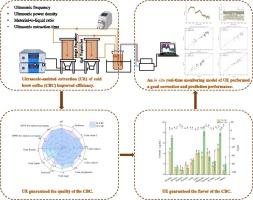Dual-frequency countercurrent ultrasonic-assisted extraction of the cold brew coffee and in situ real-time monitoring of extraction process
IF 8.7
1区 化学
Q1 ACOUSTICS
引用次数: 0
Abstract
This research aimed to examine the effect of countercurrent ultrasound on extraction efficiency of cold brew coffee (CBC). The quality and flavor of CBC obtained by ultrasonic-assisted extraction (UE) were evaluated and compared with traditional extraction (TE). Meanwhile, the UE process was monitored in situ real-time using a near-infrared (NIR) spectrometer. The optimal UE parameters obtained by experiments were dual-frequency of 20/28 kHz, countercurrent ultrasonic treatment time of 50 min, ultrasonic power density of 320 W/L, and material-liquid ratio of 1:15. Under the optimal parameters, the total dissolved solids content (TDS) and extraction yield (EY) were 1.63 % and 20.52 %, respectively. This resulted in an 83.33 % improvement in efficiency matching the TDS and EY of a 5-h TE CBC. In comparison with the control, the contents of total polyphenols, total sugars, and total lipids after ultrasonic treatment increased by 13.79 %, 28.49 %, and 333.33 %, respectively, while the total acids content decreased by 27.81 %. HPLC and HS-SPME-GC/MS analysis showed similar non-volatile and volatile flavor components between UE and TE CBC. A quantitative partial least squares (PLS) prediction model was developed to monitor TDS and CGA levels during the UE CBC. This model demonstrated excellent calibration and prediction performance. (TDS: Rc = 0.9281; RMSECV = 0.0694; Rp = 0.9514; RMSEP = 0.0631. CGA: Rc = 0.9086; RMSECV = 0.0316; Rp = 0.9467; RMSEP = 0.0212). This study explored an efficient approach for the industrialization of CBC production and provided theoretical support for developing an intelligent control system for its process.

冷萃咖啡的双频逆流超声波辅助萃取和萃取过程的现场实时监控。
本研究旨在探讨逆流超声波对冷萃咖啡(CBC)萃取效率的影响。通过超声波辅助萃取(UE)获得的冷萃咖啡的质量和风味与传统萃取(TE)进行了评估和比较。同时,使用近红外(NIR)光谱仪对 UE 过程进行了现场实时监测。实验得出的最佳超声萃取参数为双频 20/28 kHz、逆流超声处理时间 50 min、超声功率密度 320 W/L、料液比 1:15。在最佳参数下,总溶解固体含量(TDS)和萃取率(EY)分别为 1.63 % 和 20.52 %。因此,与 5 小时 TE CBC 的 TDS 和 EY 相比,效率提高了 83.33%。与对照组相比,超声波处理后的总多酚、总糖和总脂含量分别增加了 13.79 %、28.49 % 和 333.33 %,而总酸含量则减少了 27.81 %。HPLC 和 HS-SPME-GC/MS 分析表明,UE 和 TE CBC 的非挥发性和挥发性风味成分相似。开发了一个定量偏最小二乘法(PLS)预测模型,用于监测 UE CBC 期间的 TDS 和 CGA 水平。该模型显示出出色的校准和预测性能。(TDS:Rc = 0.9281;RMSECV = 0.0694;Rp = 0.9514;RMSEP = 0.0631。CGA:Rc = 0.9086;RMSECV = 0.0316;Rp = 0.9467;RMSEP = 0.0212)。这项研究为 CBC 生产的工业化探索了一条有效途径,并为开发其流程的智能控制系统提供了理论支持。
本文章由计算机程序翻译,如有差异,请以英文原文为准。
求助全文
约1分钟内获得全文
求助全文
来源期刊

Ultrasonics Sonochemistry
化学-化学综合
CiteScore
15.80
自引率
11.90%
发文量
361
审稿时长
59 days
期刊介绍:
Ultrasonics Sonochemistry stands as a premier international journal dedicated to the publication of high-quality research articles primarily focusing on chemical reactions and reactors induced by ultrasonic waves, known as sonochemistry. Beyond chemical reactions, the journal also welcomes contributions related to cavitation-induced events and processing, including sonoluminescence, and the transformation of materials on chemical, physical, and biological levels.
Since its inception in 1994, Ultrasonics Sonochemistry has consistently maintained a top ranking in the "Acoustics" category, reflecting its esteemed reputation in the field. The journal publishes exceptional papers covering various areas of ultrasonics and sonochemistry. Its contributions are highly regarded by both academia and industry stakeholders, demonstrating its relevance and impact in advancing research and innovation.
文献相关原料
公司名称
产品信息
上海源叶
4-methyl-2-pentanol
上海源叶
ABTS
上海源叶
DPPH
上海源叶
trigonelline
 求助内容:
求助内容: 应助结果提醒方式:
应助结果提醒方式:


